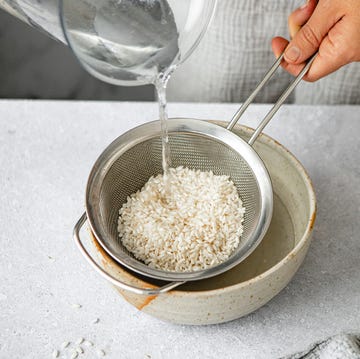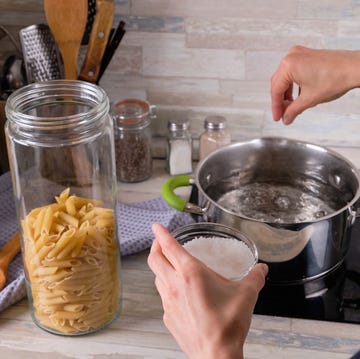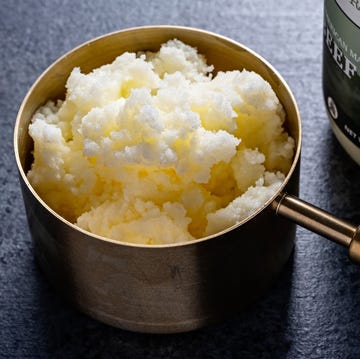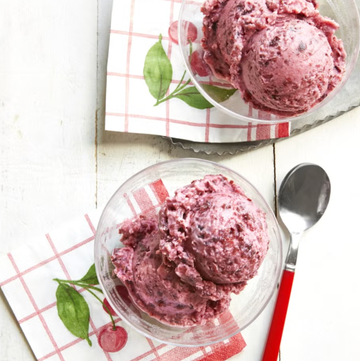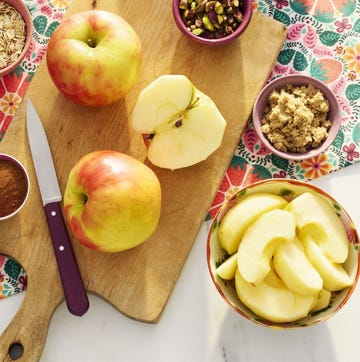1Flour Substitute: Cake or Pastry Flour
 Ralph Smith
Ralph SmithSimilar to all-purpose flour, cake and pastry flours are made from milled wheat, but they have a lower protein content. Cake flour makes baked goods light and tender—and it’s the key ingredient in Ree’s Perfect Pancakes. You can use cake flour and AP flour interchangeably if you’re in a pinch. To make your own cake flour, combine ¾ cup all-purpose flour with 3 tablespoons cornstarch.
2Flour Substitute: Bread Flour
 Westend61//Getty Images
Westend61//Getty ImagesUnlike cake flour, bread flour is on the opposite end of the spectrum when it comes to protein. It has a higher protein content that forms even more gluten when the dough is kneaded. It’s perfect for sturdy baked recipes, like (you guessed it) bread! You can use bread flour in place of most flours on a 1:1 ratio, but be careful not to over-mix. Or try using bread flour in Pastor Ryan’s recipe for homemade bread.
Advertisement - Continue Reading Below
3Flour Substitute: Self-Rising Flour
 Ralph Smith
Ralph SmithFirst things first: Don’t use self-rising flour in place of all-purpose flour. Self-rising flour is made from a mixture of AP flour, baking powder, and salt, so if you tried to use it in place of AP, you would need to adjust the amount of leavening agent and salt—and that just seems too complicated! Self-rising flour is often used in quick-bread recipes and biscuits. If your recipe calls for self-rising flour and all you have is AP, you can easily make it yourself by combining 1 ½ teaspoons of baking powder and ¼ teaspoon of salt for each cup of flour used.
4Flour Substitute: Whole Wheat Flour
 YelenaYemchuk//Getty Images
YelenaYemchuk//Getty ImagesUnlike refined all-purpose flour, whole wheat flour retains its nutrients and fiber by keeping the grain’s germ and bran intact. It’s made from red wheat, which gives it a darker color, coarse texture, and hearty taste. But be careful when baking with 100% whole wheat flour—it can make your cakes denser and drier. Instead, try using half whole wheat flour and half all-purpose.
You can also find white whole wheat flour in some stores. It’s made from white wheat instead of red, but still has that same nutty flavor as whole wheat.
Advertisement - Continue Reading Below
5Flour Substitute: Almond Flour
 Ralph Smith
Ralph SmithThis nut-based flour, sometimes called almond meal, is made from ground raw almonds. It’s high in fiber, plus it’s gluten-free, paleo-friendly, and low in carbs! Because almond flour doesn’t contain the gluten needed for giving cakes their structure, it’s not recommended to use in place of AP flour. However, if the recipe calls for just a small amount of flour or if you're dredging fried chicken, you can usually swap in almond flour.
6Flour Substitute: Oat Flour
 Alikaj2582//Getty Images
Alikaj2582//Getty ImagesThis gluten-free flour is made from ground oats. It has a slightly nutty flavor that tastes great in pancakes, waffles, and granola bars. If you simply can’t find any flour at the store, pick up a bag of rolled oats and zap them in a blender or food processor for a few seconds until you have a powder-y, flour-like texture. The fiber from the oats makes it a healthy option for swapping with AP flour!
Advertisement - Continue Reading Below
7Flour Substitute: Millet Flour
 Karisssa//Getty Images
Karisssa//Getty ImagesAnother gluten-free option! This flour is ground from a tiny ancient grain that boasts a ton of nutrition, including fiber and magnesium. For best results, use a combination of millet flour and AP flour when baking, unless otherwise called for.
8Flour Substitute: Rice Flour
 Diana Taliun//Getty Images
Diana Taliun//Getty ImagesThis flour comes in both white and brown rice options. It makes a great flour substitute; however, it tends to be a little gritty, so look for one labeled "finely ground." Try rice flour when making fried calamari or tempura. We especially like brown rice flour for its slightly nutty flavor.
Advertisement - Continue Reading Below
9Flour Substitute: Coconut Flour
 HandmadePictures//Getty Images
HandmadePictures//Getty ImagesCalling all keto lovers! Coconut flour is a high fiber, low-carb, gluten-free alternative flour made from dried coconut. It has a distinct tropical flavor, so it’s not perfect for all recipes, not to mention it absorbs a ton of moisture, which can make your baked goods dense. Use it in combination with other flours and note that you may need to add extra liquid or fat to the recipe.
10Flour Substitute: Buckwheat Flour
 Maryna Iaroshenko//Getty Images
Maryna Iaroshenko//Getty ImagesDon’t be fooled! Buckwheat flour isn’t actually made from wheat at all, but from buckwheat seeds that are gluten-free. It has a nutty flavor that’s best used as a substitute for AP flour when making chocolate chip pancakes or muffins. Did you know that soba noodles are made from buckwheat flour?
Advertisement - Continue Reading Below
11Flour Substitute: Spelt Flour
 RachelDewis//Getty Images
RachelDewis//Getty ImagesYou won’t believe the flavor that spelt flour provides! It’s a type of wheat flour that has a similar protein content to all-purpose, but it has a nutty flavor that’s delicious in chocolate chip cookies. You can use it cup for cup in place of AP, but check to make sure your batter has enough moisture (it may need some adjusting).
12Flour Substitute:Chickpea Flour
 rezkrr//Getty Images
rezkrr//Getty ImagesChickpeas (or garbanzo beans) are high in protein and fiber, which makes them super filling. There are so many ways to use chickpeas, but did you know there’s also flour made from chickpeas? It’s great for savory and sweet baked goods.
Advertisement - Continue Reading Below
13Flour Substitute: Amaranth Flour
 The Pioneer Woman
The Pioneer WomanWith more protein than wheat, amaranth flour is a healthy, gluten-free alternative. It can be tender when used in small amounts—try using amaranth flour for up to 25% of all-purpose flour in your recipe, especially scones and pancakes.
14Flour Substitute: Potato Flour
 al62//Getty Images
al62//Getty ImagesPotato flour is made from whole potatoes that have been dried and ground (not to be confused with potato starch). It absorbs moisture really well, which is why it’s great as a thickener for soups and sauces. When it comes to baking with potato flour, it’s best to stick to recipes that call for it.
Advertisement - Continue Reading Below
15Flour Substitute: Rye Flour
 SasaJo//Getty Images
SasaJo//Getty ImagesRye flour can range from light to dark and has a slightly sour flavor. You may recognize the taste from the classic rye sandwich bread at your local deli. Even though rye flour contains some gluten, it doesn't have a lot, so it needs to be combined with another flour to help it rise. The more rye flour used, the denser the bread will be.
16Flour Substitute: Quinoa Flour
 bhofack2//Getty Images
bhofack2//Getty ImagesRee loves using quinoa as the base for this filling roasted vegetable salad, but when quinoa is ground into a flour, it can also be used to add nutty flavor to brownies and quick breads.
Advertisement - Continue Reading Below
Advertisement - Continue Reading Below
Advertisement - Continue Reading Below



